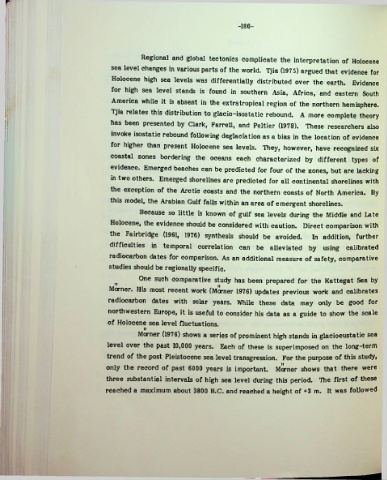Page 204 - Life & Land Use on the Bahrain Islands (Curtis E Larsen)
P. 204
r
-180-
Regional and global tectonics complicate the interpretation of Holocene
sea level changes in various parts of the world. Tjia (1975) argued that evidence for
Holocene high sea levels was differentially distributed over the earth, Evidence
for high sea level stands is found in southern Asia, Africa, and eastern South
America while it is absent in the extratropical region of the northern hemisphere.
j| Tjia relates this distribution to glacio-isostatic rebound. A more complete theory
has been presented by Clark, Farrell, and Peltier (1978). These researchers also
invoke isostatic rebound following deglaciation as a bias in the location of evidence
for higher than present Holocene sea levels. They, however, have recognized six
coastal zones bordering the oceans each characterized by different types of
evidence. Emerged beaches can be predicted for four of the zones, but are lacking
in two others. Emerged shorelines are predicted for all continental shorelines with
the exception of the Arctic coasts and the northern coasts of North America. By
this model, the Arabian Gulf falls within an area of emergent shorelines.
Because so little is known of gulf sea levels during the Middle and Late
Holocene, the evidence should be considered with caution. Direct comparison with
the Fairbridge (1961, 1976) synthesis should be avoided, In addition, further
difficulties in temporal correlation can be alleviated by using calibrated
radiocarbon dates for comparison. As an additional measure of safety, comparative
studies should be regionally specific.
One such comparative study has been prepared for the Kattegat Sea by
m it
Mcrner. His most recent work (Mcrner 1976) updates previous work and calibrates
radiocarbon dates with solar years. While these data may only be good for
northwestern Europe, it is useful to consider his data as a guide to show the scale
of Holocene sea level fluctuations.
it
Morner (1976) shows a series of prominent high stands in glacioeustatic sea
level over the past 10,000 years. Each of these is superimposed on the long-term
trend of the post Pleistocene sea level transgression. For the purpose of this study,
only the record of past 6000 years is important. Mcrner shows that there were
three substantial intervals of high sea level during this period. TTie first of these
reached a maximum about 3800 B.C. and reached a height of +3 m. It was followed

